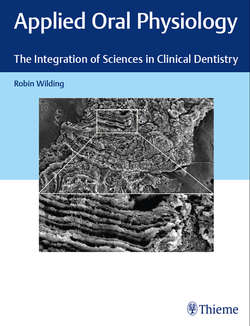Читать книгу Applied Oral Physiology - Robin Wilding - Страница 43
На сайте Литреса книга снята с продажи.
3.3.3 Gustatory Mucosa
ОглавлениеThe dorsal surface of the tongue is covered with a specialized mucosa which has both taste and masticatory function. Taste buds lie within the epithelium over the surface of the tongue, the soft palate, and epiglottis. The tongue is divided into two parts, an anterior two-thirds and a posterior third, by a V-shaped groove, the sulcus terminalis. The epithelium of the tongue is highly keratinized with pointed projections of keratin with a core of lamina propria. The keratin at the tip is extended into a short spiky process. These fine projections are known as filiform papillae. The tongue may appear fury if during illness this keratin is not worn away. The purpose of these papilla in man is uncertain. They probably serve a similar function as in other mammals where they protect the surface of the tongue from the abrasive action of rough foods. They also serve to provide a grip on slippery foods in order to form a bolus and to cleanse the oral surfaces of food debris. There are larger, less thread-like papillae of the tongue called fungiform papillae from their resemblance to a mushroom. They are scattered singly over the tongue but concentrated near the tip. The epithelium of fungiform papillae contains taste buds. The vallate papillae are prominent features, just anterior to the sulcus terminalis. There are only about 12 vallate papillae and they do not project above the surface. The furrow contains numerous taste buds and the openings of the serous glands of von Ebner. The foliate papillae are projections around the side of the tongue and have no special function.
Taste buds are oval structures within the epithelium of the tongue. They consist of elongated cells packed together whose ends open out into a pit below an opening in the epithelium. Not all the cells are active, but some may be either supportive to, or precursors of, active cells. The number of taste buds diminishes with age. The sensory supply to the anterior two-thirds is via the lingual branch of the mandibular nerve. The taste sensations are carried via the chorda tympani branch of the facial nerve. The posterior third receives its sensory supply from the glossopharyngeal nerve. The motor supply to all muscle of the tongue except the glossopharyngeus is the hypoglossal nerve.
The periodontium is a term used to describe the supporting and investing structures of the tooth. These comprise the alveolar bone, periodontal ligament, cementum, and the gingiva, an important component of which is the gingival attachment to the tooth by the junctional epithelium. We have reviewed the structure of the gingiva and gingival attachment, so what follows are the other components of the periodontium, the alveolar bone, cementum, and periodontal ligament.
Key Notes
A removable dental prosthesis may have to derive occlusal support from the residual alveolar ridge. The thickness, and resilience to displacement, of the mucosa overlying the residual ridge exhibits regional variation. This variation may limit the ability of the mucosa in certain regions to resist compression caused by masticatory forces. These limitations may determine the patient’s ability to tolerate the prosthesis.
